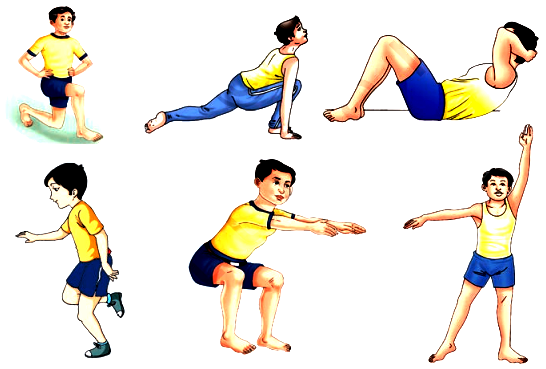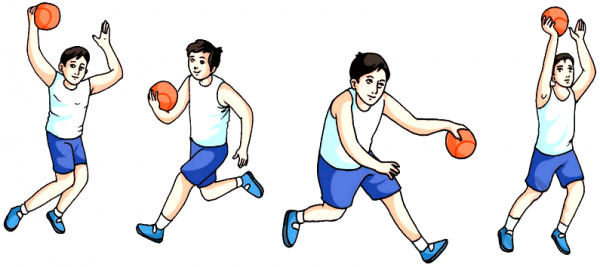Warming up is a short time activity carried out prior to any intense or skilled activity. It is important to warm up before exercising, which is usually done by including 10 to 40 minutes of light activities, such as, slow jog, calisthenics, and stretching. Players need warm-up as it increases body temperature and heart rate, provide stretching, stimulate the entire body and major biomechanical functions, provide practice for basic movements, and finally prepare the player or athlete for rigorous athletic activity/training. Stretching results in increased blood flow and prevents injuries to the muscles, tendons, and ligaments. Proper warm-up exercises are not supposed to be done vigorously. A warm-up generally consists of a gradual increase in intensity of physical activity (a ‘pulse raiser’), joint mobility exercise, and stretching, followed by the main activity. Warming up brings the body to a condition at which it safely responds to nerve signals for quick and efficient action. The objectives of the warm-up are to increase heart rate, blood flow, internal temperature of the muscles, respiratory rate, perspiration, and decrease the viscosity of joint fluids.
A warm-up is intended to raise the body temperature and prepare a player physiologically and psychologically to compete in a game. Researchers have suggested that the optimum duration of the warm-up period, should be between 15 to 20 minutes. This should consist of a gradual increase in intensity until the player is working at 70 per cent of maximal heart rate. A warm-up at this intensity has the effect of allowing an increase in the range of movement of the joints and improving aerobic performance. This means the player becomes more flexible and movement efficiency improves. A warm-up produces a 2 to 3 degree rise in body temperature that can last for 45 minutes.
Types of Warm-up :
1. General Warm-up
2. Specific Warm-up
General warm-up exercises

General Warm-up
It involves rhythmic movements using large muscle groups. The general warm-up should consist of a light physical activity like walking, jogging, stationary bike, skipping, or easy aerobics. It is also beneficial in improving neuromuscular coordination of muscles that results in developing better control on muscles. This warming up in turn increases the body temperature resulting in reduced viscosity in muscle fibres and thus helps in getting better results. Both the intensity and duration of the general warm-up (or how hard and how long), should be governed by the fitness level of the participating athlete.
Specific Warm-up
It consists of specific exercises which are matched to the main activity. In specific warm-up, some special sets of exercises need to be performed which have a direct relation with the activity to be carried out. In this part, the athletes are specifically preparing their body for the demands of their particular sport. During this part of the warm-up, more vigorous activity should be employed. Activities should reflect the type of movements and actions which will be required during the sporting event. The set of activities and exercises in specific warming up differ from sport to sport. These are especially designed to meet the requirement of different activities and sports.
For example in weightlifting, the athlete first needs to perform some exercises with a bar for specific warm-up. Similarly a basketball player practices layup shots or free throws before the competition, this helps to improve their coordinating abilities. Different games have their own specific warm-up exercises.
Some of them are described (along with the games they concern) as follows:
1. Basketball—shooting, dribbling, lay-up shots, free throws, shuttle run, dodging, etc.
2. Cricket—bowling, catching, batting, fielding, running, etc.
3. Lawn Tennis—wall practice, service practice, passing shots, knocking, etc.
4. Shot put—standing throws, putting the shot with both hands, gliding practice with or without shot, shifting the shot from left hand to right hand, and vice-versa.
5. Hockey—dribbling, rotation of stick, short passes, long hits, scoop, stopping the ball with stick, etc.
6. Weightlifting—warming up rowing, high pull, snatch squat, shoulder shrug, good morning exercise, etc.
Different types of warming up drills in basketball

Methods of Warming up
There are various methods of warming up for different games and sports, the most commonly used are by—
1. exercise
2. massage
3. taking hot water bath
4. sipping some hot beverages.
Exercise
Most sets of warm-up exercises include four to five very simple movements. The exercises that are included in this method are walking, jogging, running, jumping, bending, stretching exercises, etc.
Massage
Massaging of muscles is a good method to gain muscle tone and is an effective means of warming up. It helps in the removal of lactic acid and recovery from fatigue and healing of minor injuries of muscles.
Hot Water Bath
This technique is very helpful in warming up and relaxation of muscles after competition. A hot water bath is helpful in raising body temperature which results in the activation of muscles by increasing blood circulation in them.
Hot Beverage
A small intake of tea, soup, coffee, or any other hot beverage stimulates the body functions and helps in preparing the body for competition. The drink should not be consumed in large quantities as it may cause discomfort.
Things to take into account when performing the warm-up:
- Always start with a continuous slow run to prepare the body and increase temperature. Move all the parts of your body, from head to toes.
- Do not get tired; don’t make too many repetitions of each movement and move the alternate parts of the body.
- It has to be progressive, from low-intensity to highintensity exercises.
- End up with some sprints or short, and fast races. It should last for 10–15 minutes, and your heart rate should increase until 120–140 beats/minute.